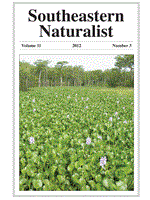Point-count surveys are useful in collecting information on breeding birds; however, species that are elusive, occupy dense forests, or call infrequently may be undersampled. In this study, we examined the responsiveness of Coccyzus minor (Mangrove Cuckoo) to call playbacks in southern Florida from May to June in both 2010 and 2011. Our objective was to determine if playback surveys would increase the detectability of Mangrove Cuckoos. At each of the 111 experimental points, either recorded Mangrove Cuckoo vocalizations (treatment) or no vocalizations (control) were broadcasted. We detected Mangrove Cuckoos at 14 of the 67 treatment points (20.9%) and at 1 of the 44 control points (2.3%), suggesting that using call-playbacks significantly increased the likelihood of detecting a Mangrove Cuckoo (P = 0.01) as compared to passive pointcount methods. In recent years, sharp declines in Mangrove Cuckoo populations have been noted, and little is known about their overall ecology. Before conservation for this species can take place, it is necessary to fill basic information gaps such as distribution and abundance. Once distribution is better understood, critical habitat can be protected and monitoring the effects of climate and habitat change can occur. Increasing the detectability of these birds is an important step toward achieving these goals.
How to translate text using browser tools
1 September 2012
Responsiveness of Mangrove Cuckoo (Coccyzus minor) During Call-Playback Surveys in Southern Florida
Rachel D. Frieze,
Stephen M. Mullin,
John D. Lloyd
ACCESS THE FULL ARTICLE

Southeastern Naturalist
Vol. 11 • No. 3
September 2012
Vol. 11 • No. 3
September 2012




